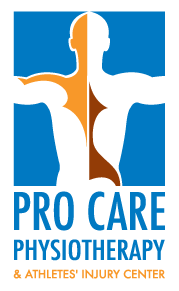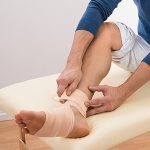
Have you ever seen a jogger whizzing past you wearing a bright piece of tape strapped across their hamstring, shoulder blade, or shin? That’s not a fashion statement, that’s athletic tape. This type of rehabilitation product has been used by athletes and exercise enthusiasts for decades and continues to be a popular method of pain management. Advances in technology are allowing tapes to become more effective and beneficial to the wearer and are often recommended by sports doctors and physiotherapists.
What is Athletic Tape?
Athletic tape is an umbrella term for any athletic ribbon or bandage that’s strapped to a part of the body that has been injured or inflamed in some way. The strategic placement of the tape has been known to speed up healing and provide support to the injured area as it heals. Some tapes like Coban bandages, under tape, and rigid tape, provide different levels of support, breathability, and flexibility. The type of athletic tape that is undoubtedly gaining popularity is kinesiology tape.
Benefits of Kinesiology Tape
Developed in the early 1970s, kinesiology tape is completely flexible and manufactured to have the same feel of skin. Made of stretchy cotton material with a heat-activated adhesive, kinesiology tape is used by athletes to improve their performance and receive dynamic support for injured or inflamed joints and muscles. Unlike many other athletic taping methods, kinesiology tape can be worn for up to a week, which accelerates the healing process.
Here are other reasons physiotherapists recommend kinesiology tape:
– For Pain Relief
– Kinesiology tape is known for its “lifting properties”, which reduces pressure on the painful area.
– To Reduce Swelling and Inflammation
– Taping improves the drainage of lymphatic channels that reduces swelling
– For a Speedy Recovery
– The unique tape allows the wearer to return to their sport or activity by relieving pain and supporting weak or fatigued muscles as they move.
– For Muscle Injuries, Cramps, and Fatigue
– The buildup of lactic acid in the muscle leads to painful cramping, strains, and delayed onset muscle soreness. Kinesiology tape reduces lactic acid in – that region to improve your performance and prevent muscle cramps from getting in the way of your activity.
– Kinesiology tape provides neurological and physical support. It also stabilizes the muscles to prevent further injury.
– Tips for Wearing Athletic Tape
There are many more benefits to wearing athletic or kinesiology tape than we listed here. If you’re already excited to give athletic tape a try, here are a few tips to ensuring the safe and effective use of this rehab product:
– Use only as directed: It’s easy to get excited about a non-invasive pain management product, especially if you’re a chronic sufferer. In order to get the maximum benefit from athletic tape, however, we suggest consulting with your physiotherapist first. Not only will they be able to determine if athletic tape is suitable for your injury, they will also be able to show how to wear it properly.
– Make sure your skin is prepared for taping: it might be worthwhile to consider removing hair and taking care of cuts or lesions before applying the tape, especially kinesiology tape.
– Learn about the proper tape removal methods before applying it to your skin.
Pro Care Physiotherapy sometimes recommends physiotherapy products to our patients, however, only when necessary. We do not recommend buying athletic tape or any other rehab products without first consulting a member of our staff. The inaccurate application of athletic tape may cause further pain or injury. To find out if you can benefit from athletic taping, speak to your therapist at your next appointment or contact Pro Care Physiotherapy today.
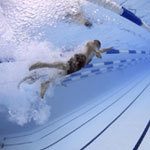
Swimming is a relaxing and joyful pastime adored by people of all ages. From surfing the waves to splashing around in a wading pool, people always love a good swim. But did you know that swimming, or hydrotherapy, could useful in your physiotherapy? Thanks to your body’s unique buoyancy, swimming is a helpful and relaxing exercise that may help your body heal faster from your injury or illness. Here are some positive benefits to incorporating swimming into your physical therapy.
Swimming for Back Pain
Swimming is a unique form of physical exercise because there is little to no impact on your body. By bobbing in the water, your entire back, spine, and neck will feel supported, allowing your muscles to relax and loosen. If you suffer from back pain, speak to your physiotherapist about swimming exercise that will help target the pain. To help ease the tension and pain in your back, try floating on your back and performing strokes that don’t require twisting or bending.
Swimming for Knee and Joint Pain
In water, your body will always fight to stay afloat, which is called buoyancy. Because of your body’s buoyancy, your bones, muscles, and joints will not feel the hard impact of exercise as gravity drags you down. Running, cycling, weight-lifting, and other organized cardio activities put a major strain on your muscles, joints, and bones, which is a major factor in knee and joint pain. Knee pain can significantly impact your ability to stay active and exercise, therefore, swimming may be recommended by your physiotherapist. Although it may not feel like it, swimming offers a safe and highly resistant workout, which is ideal for strength training. Don’t feel like you’re getting the workout you’re used to? Due to the water’s cooling effect, you may not feel like your body is working up a sweat, but trust us, it is!
Swimming for Stress Management
Stress can lead to muscle spasms, which are painful and uncomfortable. Swimming is proven to relieve physical and mental stress. While stress should be mitigated by eliminating the stressors in your life, a holistic approach to stress management, like acupuncture, meditation, and swimming, could significantly reduce your stress levels. Swimming is a relaxing and calming exercise, and the simple act of floating on your back may help lower stress levels and ease tension in your muscles. Swimming is proven to reduce pain caused by arthritis and fibromyalgia.
Swimming for Fun!
Swimming has so many positive associations. Many people spent their childhood summers within a few feet of a pool, lake, or beach. Swimming is an activity that is enjoyed by people of all ages. Swimming can be a time to practice your breaststroke or a moment to share with friends and family. The beauty of this form of exercise is that you can take it as seriously as you want, and even while you’re splashing around and playing an intense round of Marco Polo, your body will still enjoy the benefits of being submerged in water.
Pro Care Physiotherapy in Ottawa creates customized treatment techniques that often involve hydrotherapy. Contact us today to discuss your physical therapy needs.

How is that office chair you’re sitting on? Is it comfortable? Cushiony? Top-of-the-line? Unfortunately, none of that matters if you’re slouching in it right now. There’s even a good chance that your chair, as comfortable as it is, is going to cause you back pain some day soon. In order to practice proper posture and to ensure your daily activities aren’t leading you down the road to pain, every part of your desk setup needs to support you. If you’re starting to feel aches and pains at the office, here’s how to fix it.
To Prevent Lower Back Pain & Strain
Have you ever noticed that the longer you sit at your desk, the more your back starts to slouch? We all do it, however, that’s a major cause for lower back pain. If you find yourself slouching a lot, there’s a chance your lower back is not being supported. Fortunately, your chair can easily be adjusted. With the lever, set the height of the chair so that your elbows are at a 90 degree angle when placed on top of your workstation or keyboard. You should be sitting completely on the chair with your lower back fully resting on the back of the chair.
To Prevent Shoulder Pain
Too much strain on your upper spine can cause a burning-numbing sensation in your shoulders. There are two major causes for this, and both are easily fixed. First of all, ensure that your computer screen is at eye level. If you have to constantly bow your head to do your work, then your screen is too low. Resist the temptation to adjust your chair. Lift the screen instead using an elevated mount or even a stack of books. You will know when the screen is at the right height when you’re looking straight ahead.
Gravity is the second reason for your shoulder pain. With arms constantly elevated in front of you, your elbows will start to feel heavy and pull you down, which is also another reason for your slouching. Adjust your arm rests just enough so that your elbows are resting gently at the 90 degree angle. Your shoulders and neck will thank you.
To Prevent Carpal Tunnel Syndrome
As your wrists start to swell up, ache, and send tingling sensations up and down your arm, your work productivity will begin to suffer. If you’ve reached this point, you’re likely experiencing something called carpal tunnel syndrome, which is pressure on the median nerve inside your carpal tunnel that is caused by excessive or repetitive wrist movement. The main culprit of office carpal tunnel syndrome is the unnatural positioning of your hands as you type and scroll with your mouse. If your wrists are sensitive to swelling, request to have an ergonomic mouse and keyboard installed at your workstation, which will allow your wrists to sit more naturally at a slightly outturned angle.
Get Up & Move
Historically speaking, the human race has never been more sedentary. Up until the last century, we have had to constantly move to make money, source our food, and travel from place to place. But as jobs became physically less demanding and life grew easier, our bodies started to bear the brunt of the new way of life. In other words, our bodies aren’t designed to sit down for long periods of time. If your job forces you at a desk for eight hours day, try to spend 10 minutes of each hour standing, walking, stretching and moving. Taking these small little breaks may seem useless, but they’re just enough to combat muscle and joint strain.
If you feel aches and pains from your office workstation, contact Pro Care Physiotherapy today. We will work with you to alleviate your pain and to help you adjust your office space to prevent further injury.
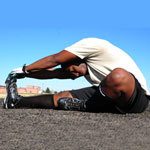
You don’t have to be a paid athlete to get seriously hurt. A sports injury is any injury that occurs while exercising or playing a sport, whether it’s a friendly game of soccer with some buddies or a professional NHL hockey game. Watching our favourite sports team on television has taught us that sports injuries are common and can be quite severe. If left untreated, they can cause long-term health issues, so it’s important to see your Ottawa sports injury physiotherapist to discuss treatment. Here are three common sports injuries and how to avoid them:
#1: Sprains and Strains
A sprain occurs when the ligaments in the joint are suddenly and accidentally torn or twisted. A very common example is an ankle sprain, which generally happens in sports where a lot of jumping or close contact with other players (and their feet) are involved. Sprains are extremely painful and cause almost immediate swelling of the area.
To avoid sprains:
-Wear proper footwear
-Stretch before you engage in physical activities
-Improve strength around your joints through exercise
A muscle strain is a common exercise injury. Often our muscles get strained from improper use of exercise equipment, such as lifting weights that are too heavy, doing too many reps, or executing movements with bad form. Strains are common in people who are new to certain equipment, but it can happen to anyone.
To avoid strains:
-Warm up before you start working out to prepare your muscles for strenuous activity.
-Choose appropriate weights that aren’t too heavy. Discomfort is normal, pain is not
-Stretch after your workout.
-Ask your physiotherapist about the proper use of weights and good form while exercising.
#2: Plantar Fasciitis
Plantar Fasciitis is more than just sore feet after a long walk. The pain is intense and the recovery can be long. People often associate plantar fasciitis as an ailment of the elderly, but it’s a sports injury that’s common for people who are on their feet all day long or who walk or run great distances, such as dog walkers and athletes. Plantar fasciitis occurs when the plantar fascia ligament that connects your heel to your toes, and which supports your arch, is strained. The pain starts at the heel and then eventually creeps into the rest of your foot, making it extremely painful to walk.
To avoid plantar fasciitis:
-Check your shoes. Even if they’re high-quality running shoes, they may be worn out or don’t support your arch properly. Buy new shoes and custom orthotics that provide proper support.
-If you’re a runner, try jogging on softer terrain, such as grass or on a treadmill.
-Take care of your feet. After a day of walking or running, soak your feet and keep them elevated.
-Don’t forget to stretch.
#3: Tennis Elbow
Not just for tennis players. Tennis elbow, or lateral epicondylitis, occurs with constant and repetitive use of your wrist and forearm muscles while holding on to something, such as your tennis racket. Overusing our arms causes the tendons to become inflamed, which leads to pain and discomfort. Tennis elbow is not just an injury for athletes. Many professionals whose jobs require repetitive wrist & arm motions can also suffer from tennis elbow, such as carpenters, painters, and plumbers.
To avoid tennis elbow:
-Warm up and stretch before and after physical activity.
-Learn the correct techniques, i.e. how to swing a racket.
-Strength-train your muscles to better support your joints.
-Take it easy and don’t over-exert yourself.
If you’re suffering from a sports injury, we can help. You don’t have to live in pain any longer—contact Pro Care Physiotherapy in Ottawa to discuss treatment with an experienced sports injury physiotherapist.

No matter what your motivation, there is no wrong reason to get into shape. Whether it’s to look great in a bikini or to improve your overall health, the important thing is that you’re taking steps to live a healthy lifestyle. But if you’re new to weight training, there are some easy mistakes people often make that can lead to injury and prevent you from achieving your exercise goals. Avoid these common weight-training mistakes to ensure your session runs smoothly:
Mistake #1: Not Learning Proper Technique
No one will tell you not to be enthusiastic about getting into shape, but there is a right way and wrong way to lift weights. It’s one thing to walk into the gym proud as a peacock and start swinging around a kettlebell, and quite another to perform real muscle strengthening exercises. If you’re using weights wrong, you’ll find out the hard way. Bad form or technique can put an unnecessary strain on your back, knees, and other sensitive areas, leading to painful injury. Speak to your physiotherapist about learning proper weight-training techniques to prevent pain and ensure maximum benefit. Nothing is more frustrating than having to take a break from your fitness goals to tend to a preventable injury.
Mistake #2: Showing Off with too Much Weight
They put mirrors in the gym for a reason, and it’s not to make it easier to stare at your bulging biceps. If your main priority for going to the gym is to show off how much weight you can lift, then chances are you’re not paying attention to your form or listening to your body for signs of stress. Picking up weights that are too heavy can tear or strain your muscles, which will require complete rest should this occur, and slow down your fitness goals as a result.
The person next to you may be able to lift heavier weights, but everyone is different. Comparing yourself to other people who may have been training longer than you is an easy way to lose sight of your fitness goals and to get hurt. Pick a weight that doesn’t make you sacrifice proper form and that doesn’t cause pain. If you’re not sure, speak to a trainer on site.
Mistake #3: Not Giving Yourself a Break
When we’re excited about getting into shape, we tend to ride off a total health and fitness high. Staying motivated is half the battle, but if you try to do too much too fast, you may end up hurting yourself in the long run. It’s one thing to swap out everything in your fridge for lean proteins, green vegetables, and healthy oils—nobody gets injured from suddenly eating wholesome food. But if you don’t give your body the break it needs to recover from exercise, you’re going to end up with a painful injury. When you’re starting a workout regimen, remember that rest days are just as important as workout days. Resting gives your body the time it needs to repair itself, which is how your muscle strength improves. Don’t feel like giving up a workout completely? Instead of weight training, enjoy a few relaxing laps in the pool or a low-intensity yoga workout.
Nobody will ever tell you that working out is a bad idea. However, working out the wrong way can be just as bad for your body than not working out at all. To avoid these common rookie weight-training mistakes that lead to sports injury, consult a sports injury physiotherapist at Pro Care Physiotherapy in Ottawa.

The ugly truth about life is that accidents happen to good people. If someone in your family has suffered from a life-altering injury, such as a traumatic brain injury, or loss of limb, motor function or senses, their inability to live their life as they had before is an extremely difficult reality to face for both of you. Although you have not physically suffered the injury, your life will be permanently affected by it. Throughout the process of your family member’s physiotherapy and rehabilitation, consider consulting with a social worker if you often find yourself in situations:
You Forget You’re Not a Doctor
Showing your love and support to a family member who has recently suffered a trauma is important. But while they’re dealing with their physical and emotional pain, it’s crucial to remember that you’re not there to tell them what to do to, give them medical advice, or put them on a regimen of your making. If you aren’t a trained doctor or therapist, you shouldn’t be giving medical advice. Your injured family member will benefit more from seeing a real professional about their aches and pains, which will ease the burden of responsibility you feel.
You Forget About Your Life
It’s completely understandable and reasonable to want to take care of someone who is suffering. Parents who forego sleep to take care of their feverish children are perfect examples of what it means to love someone. But if tending to them at all hours of the day means that you’re leaving little time for yourself, there may be a chance that you’ve taken on too much responsibility. If your own life starts to suffer because of the added obligations of tending to someone with an injury, it may be time to prioritize. Taking some time out of your day to focus on your own needs and desires does not make you selfish. Rather, it will help you maintain balance and keep a level head.
You Don’t Know What to Do
Your loved one has suffered a traumatic injury that has likely changed their quality of life; it’s no wonder they are experiencing moments of extreme anger and depression. Your empathy and support throughout these difficult times is needed, although sometimes it doesn’t seem as if it’s appreciated. If you find that you’re constantly hitting a brick wall and that nothing you’re doing seems right, remember that it probably doesn’t have anything to do with you.
How a Social Worker Can Help
Pro Care Physiotherapy & Athletes’ Injury Center has helped many people with the long-term injuries that go deeper than physical ailments. Our Social Worker is trained at providing counselling and support to patients and their families and has become an integral member of many patients’ recovery teams. If you or your injured family member need help dealing with the new circumstances, you’re not alone. Contact Pro Care Physiotherapy today to speak to a social worker.

You know how important it is for your health to drink plenty of water. It is, after all, one of the essential elements of life. Though it’s been used for years, some people may not recognize the optimum healing and rehabilitative effect that aquatic therapy can provide. Water is the best environment to achieve full function, no matter what your injury or issue is.
What is it?
Physical therapy that is done in a pool or other aquatic environment is known by several different names including aquatherapy, aquatic therapy, water therapy, pool therapy, hydrotherapy, therapeutic aquatic exercise, or aquatic rehabilitation. It’s done under the supervision of a trained healthcare professional and is appropriate for children, as well as adults, and the elderly.
Rich history
You may assume that aquatherapy is a new idea, but it’s actually been around for thousands of years!
Here’s the proof:
Ancient Romans and Greeks were common practitioners of bathing in hot springs in order to relax and improve circulation.
Hippocrates advocated a bath in spring water as a way to treat sickness.
Swiss monks used warm water to care for the disabled and ill in their community.
Japanese hot springs are commonly used for ailments such as menstrual disorders, skin problems, constipation, and chronic pain.
Doctors in Germany strongly advocated water birthing and pediatric water therapy in the 1960s and 1970s.
Advantages
Let’s take a look at some of the wonderful benefits aquatherapy can provide:
Muscle relaxation. Warm water causes the muscles to relax and also improves peripheral circulation.
Provides resistance. The force of the water provides natural strength training.
Promotes body awareness. The warmth of the water helps you to be more in tune with your body, improves balance, and helps with trunk stability.
Gentle on injuries. If you’ve been injured or are rehabbing from a surgery, aquatherapy can provide you with strength training without putting any more stress or risking damage to your injury.
Lowered pain sensitivity. Water’s natural buoyancy alleviates much of the pain associated with related to injured or damaged joints and muscles.
Improved attitude. When you feel that you’re making progress, your attitude improves and you have the drive to keep pushing forward.
What conditions does aquatherapy help?
There are a whole host of health circumstances that can be improved by aquatic therapy.
Here are the most common:
Arthritis
Arthroscopic surgery recovery
Autism
Balance disorders
Bursitis
Cerebral palsy
Chronic pain
Depression
Idiopathic joint pain
Joint reconstruction surgery recovery
Joint replacement surgery recovery
Lower back pain
Osteoarthritis
Orthopedic injuries
Parkinson’s disease
Multiple sclerosis
Rheumatoid arthritis
Scoliosis
Stress
Spinal cord injury
Sprains and strains
Stroke
Tendonitis
Traumatic Brain Injury
As advances are being made, it’s quite possible that more ailments and/or injuries could be added to this list.
The great benefit of aquatherapy is that it provides a place for those who are injured or disabled to exercise, rehab, and regain strength and mobility in a way that they couldn’t do on land.

One undeniable fact that affects each and every person alive today is that they’re aging. No one can stop the clock. What people do have a semblance of control over is how well they age. An in-depth study published by the Journal of the American Medical Association shows that physical activity slows down and, in some cases, prevents the development of physical disabilities as people age. Walking is one of the physical activities that’s a good fit for those who are older.
Why walking?
Most older adults desire to hold onto their independence as long as they can. Regular exercise is one way to extend their autonomy for as long as possible. Walking is ideal because it’s inexpensive, simple, low-impact and almost everyone can do it. But that’s not all. There is a whole host of other reasons for seniors to lace up their walking shoes, including:
● A reduced risk of premature death.
● A lowered risk of dying from heart disease.
● A decreased risk of colon cancer.
● A lowered risk of developing high blood pressure, as well as reducing it in those who already have it.
● A lowered risk of diabetes
● A decreased risk of hypertension.
● Controlling weight.
● Increasing muscle strength, flexibility, and balance.
Because regular exercise is linked to a healthy self-worth, making walking a part of the daily routine is also a great mental boost, an important factor due to the fact that many older people are prone to depression.
An ounce of prevention
As previously mentioned, walking can prevent some of the ailments that are common among the aging.
Much of the loss of strength and endurance that they experience is actually due to inactivity and an increasingly sedentary lifestyle. Walking regularly increases mobility and keeps the body flexible. One of the deciding factors in determining if a person can still live on their own is their ability to walk and to care for themselves. Better flexibility leads to better balance, which is crucial for older people.
Poor balance quite commonly leads to falls. A fall can be difficult to recover from and may require lengthy hospital stays and time spent in rehab in order to recover fully.
A full recovery is much more likely if a person has maintained a good level of physical fitness and activity.
It’s not too late
Some older adults may assume that being past their “prime” means it’s too late to make improvements in their health. The truth is, it’s never too late!
The positive effects, mental and physical, are worth the effort. While it’s important to check in with a physician and to start slow, the benefits are still too good to pass up!
Professionals recommend beginning with 10 minutes a day and slowly working up to 150 minutes per week of walking or other low-impact exercises.
Most people desire to live on their own and care for themselves as long as they possibly can. The idea of being immobile and having to depend on others for basic care can be frightening and disheartening. Taking part in a physical activity, such as walking, can give a person more years of autonomy than they would have had if they lived a largely sedentary life.

What does it mean to approach patient treatment from a holistic perspective? Aristotle taught that systemically the whole is greater than the sum of its parts. In other words, the total effectiveness of a group of things each interacting with one another is greater than their individual, cumulative effectiveness when acting independent of one another. Physiotherapy offers just such benefit to millions of Canadians suffering from acute injury or requiring treatment, advice and intervention for chronic diseases and their side effects.
The integrated approach to health and injury treatment provided by physiotherapy can be applied to many common afflictions. From sport injuries, such as sprains, to the rehabilitation of the effects of disease and disability, to the management of chronic diseases and conditions, the advantages of a holistic approach are too numerous to count.
Physiotherapists promote and evaluate different strategies and tactics relative to the patient. Their condition, health and potential outcomes are thoroughly assessed to arrive at an optimal treatment plan. In addition to more traditional occupational treatments, the integrated system promoting overall, prolonged patient health includes education pertinent to existing and persisting health and injury issues, advice on injury prevention, council on disease prevention and the promotion of healthy lifestyles.
The short list of treatments includes but is by no means limited to:
Joint Manipulation
• Reduce pain and stiffness
• Helps reacquire optimal range of motion
Hot/Cold Packs
• Reduce pain and swelling
• Speeds healing through circulation management
• Improves movement and function
Skin and Wound Care
• Physio Therapists can debride non-viable tissue
• Implementation of healing strategies such as positioning, exercise, and range of motion improve the wound environment, and maximize overall function
Prescription, Application of Assistive, Adaptive, Supportive and Protective Devices
• Treatment of lingering physical limitations through use of appropriate, specific devices
• Custom fit and stock devices promote improved functionality and a return to activities
• Helps reacquire and improve range of motion
One of the most important considerations is the construction of a treatment and therapy plan that promotes the patient’s quality of life. Physiotherapy positively influences outcomes of acute sports injuries and chronic disease management through professional, efficient service and care. Aside from the relief of different symptoms, patients often rediscover new found freedom and independence based upon their encounter with physiotherapy. This can take the form of a senior extending their independent lifestyle because of a lessened threat of falling. It can take the form of a diabetic patient becoming more able to manage lifestyle choices contributing to better disease management. It can take the form of a competitive athlete extending their career through simple yet effective strategies to avoid constant, persistent injury while training.
No matter the situation the principles of holistic healing implemented by physiotherapists contribute to a substantial improvement in the quality of life for patients. The treatment of the physical needs and the improvement resulting from the alleviation of pain in many cases dramatically alter patients emotional condition and ability to cope with chronic conditions and painful injuries.
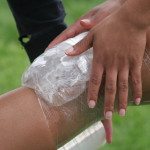
Work a 9-5 but like to break a sweat on the weekends? Here are ways to prevent the 3 most common injuries you could get.
After a long work week of sitting at your desk—or worse, sitting in traffic—nothing is better for the body and mind than exercise. Life is all about balance, isn’t it? Shooting hoops, playing 9 holes, or whacking a puck around the ice are all great ways to stay in shape, keep the heart healthy, and get the mind some of the relaxation it so badly needs. But it often happens that you forget or don’t have the time to prep and stretch before your workout, making you more susceptible to injuries. Here are the 3 most common injuries that weekend athletes encounter and what you can do to prevent them.
Ankle sprains
You know the person from accounting that stumbles into the office hobbled on one leg? They’re suffering from the most common sports injuries. Most activities involve moving our feet and our ankles; if your foot turns inward with too much weight on it, it’s going to be painful.
TIP: If you’re playing a sport like basketball, make sure to wear the right shoes and lace them up tight.
Groin pulls
Moving from side to side puts a lot of strain on the inner thigh muscles. If they move suddenly or get too much strain on them from a lunge or sudden movement in any way, there is a good chance they can tear. This is especially common for sports like football, basketball, and hockey.
TIP: Be sure to ice it down and get plenty of rest. If it starts to swell, then see a doctor immediately.
Shin splints
Those of us with a heftier build and weaker shins will most likely suffer shin splints, especially after a strenuous exercise program. These sharp pains in the shins are most common for runners of all abilities, and especially common for those of us that don’t run regularly each day.
TIP: Ice and rest are recommended. If you’re really suffering, consult your pharmacist for over-the-counter pain relievers.
Preventing these injuries
Prevention isn’t always possible since our bodies are not normally trained to perform these movements over and over again. Even professional athletes suffer from them regularly. There are a few things you can do:
- Warm up. Stretching and brisk walking do just fine, but when playing a sport, it’s important to take the time to warm up correctly. This normally means performing the same movements you will during the intense periods of the game, but at a lighter pace. For example, if you are going to play basketball, jog a bit up and down the court and move side to side in long strides. Stretch your legs up and jump a few times toward the rim for good measure.
- Extra exercise. Nothing is better for preventing injuries than exercising more frequently. If you only workout one day per week, your risk for injury is much higher. You get double the benefits: better conditioning and better health!
- Spotting fatigue. You are most vulnerable in the very beginning when your muscles are still cold and toward the end when you are fatigued. To prevent injuries when you start, warm up. To prevent them towards the end, simply stop when you’ve had enough; going that extra mile is good, but going an extra 5 miles is asking for trouble. Recognize when you’ve reached your limit and don’t strain yourself.
Preventing the most common sports injuries for weekend exercisers comes down to betting conditioning, proper warm up routines, and recognizing when you’ve reached your limit. The issue with injuries is once you get it the first time, it becomes easier to injure that same body part again. Regular trips to the physiotherapist are the best way to stay in peak form, relieve pain, and be healthier. Don’t ever stop getting the exercise you need!
← Older posts Newer posts →

